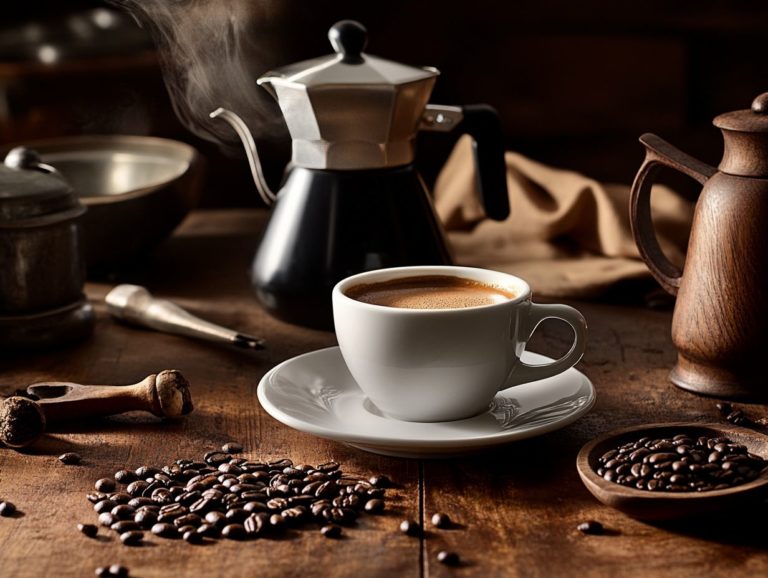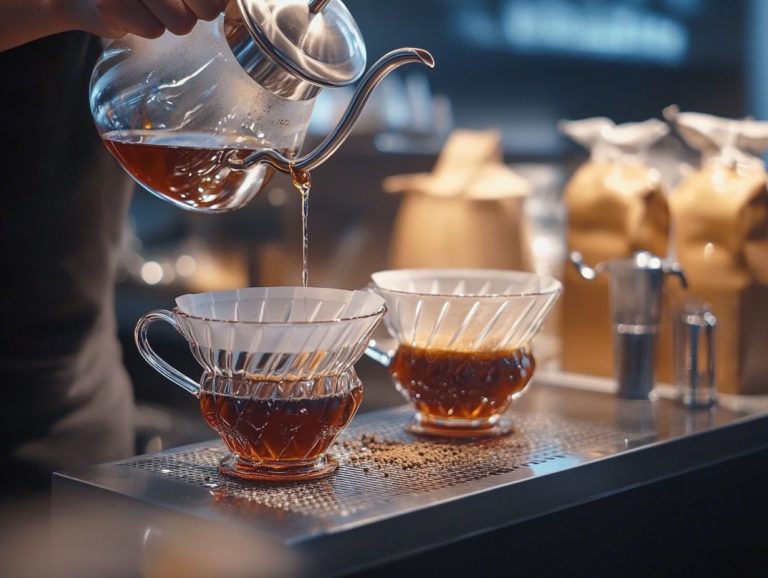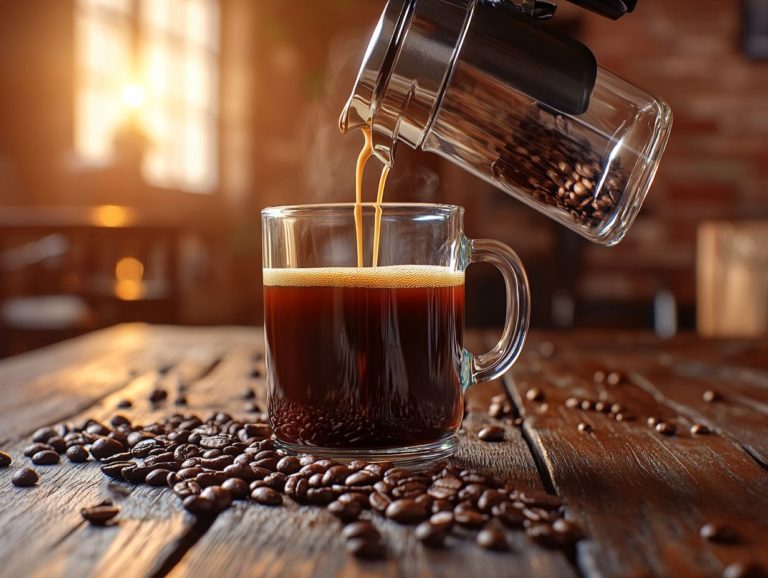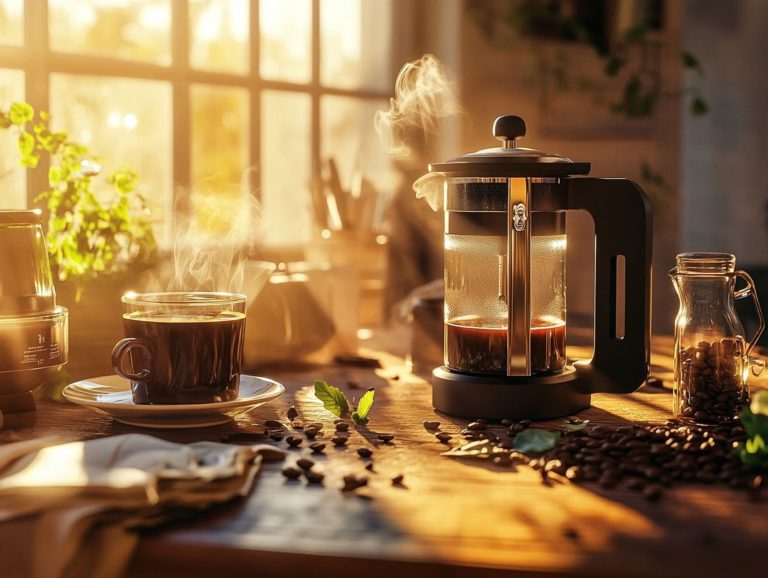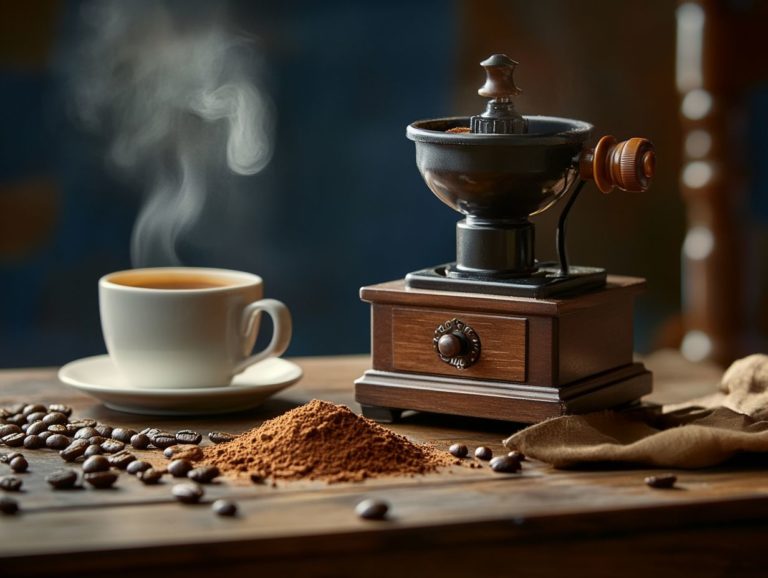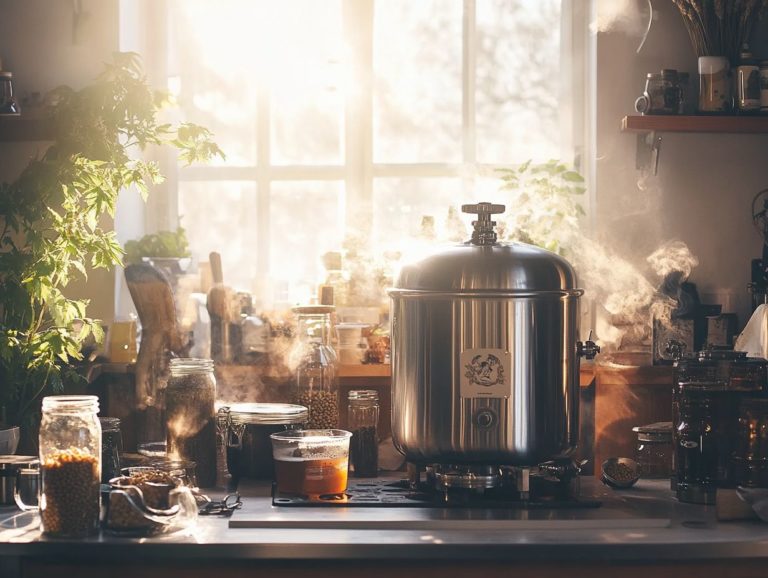The Importance of Brew Time in Coffee Flavor
Brew time stands as an important part of the exquisite art of coffee making, shaping everything from its enticing aroma to its rich taste. Understanding this crucial aspect of coffee brewing can elevate your daily coffee rituals.
By grasping how factors such as grind size, water temperature, and brewing methods interplay with brew time, you can significantly elevate your coffee experience. This knowledge benefits both passionate home baristas and seasoned coffee professionals.
This article explains why brew time is important and how it affects the flavor profiles of various coffee types. It also provides practical tips for mastering brew time, empowering you to achieve that perfect cup consistently. This guide is a must-read for anyone eager to perfect their coffee-making skills!
Contents
- Key Takeaways:
- What Is Brew Time?
- Why Is Brew Time Important in Coffee Flavor?
- Factors That Affect Brew Time
- How to Control Brew Time for Consistent Coffee Flavor
- Mastering Coffee Brewing Techniques
- 2. Experiment with Different Grind Sizes
- 3. Adjust Water Temperature
- 4. Try Different Brewing Methods
- 5. Take Note of Altitude
- 6. Keep Track of Roast Levels
- Frequently Asked Questions
- What is the importance of brew time in coffee flavor?
- How long should I brew my coffee for optimal flavor?
- What happens if I brew my coffee for too long?
- What are the effects of a shorter brew time?
- Can the brew time be adjusted for different types of coffee beans?
- How can I control the brew time for my coffee?
Key Takeaways:
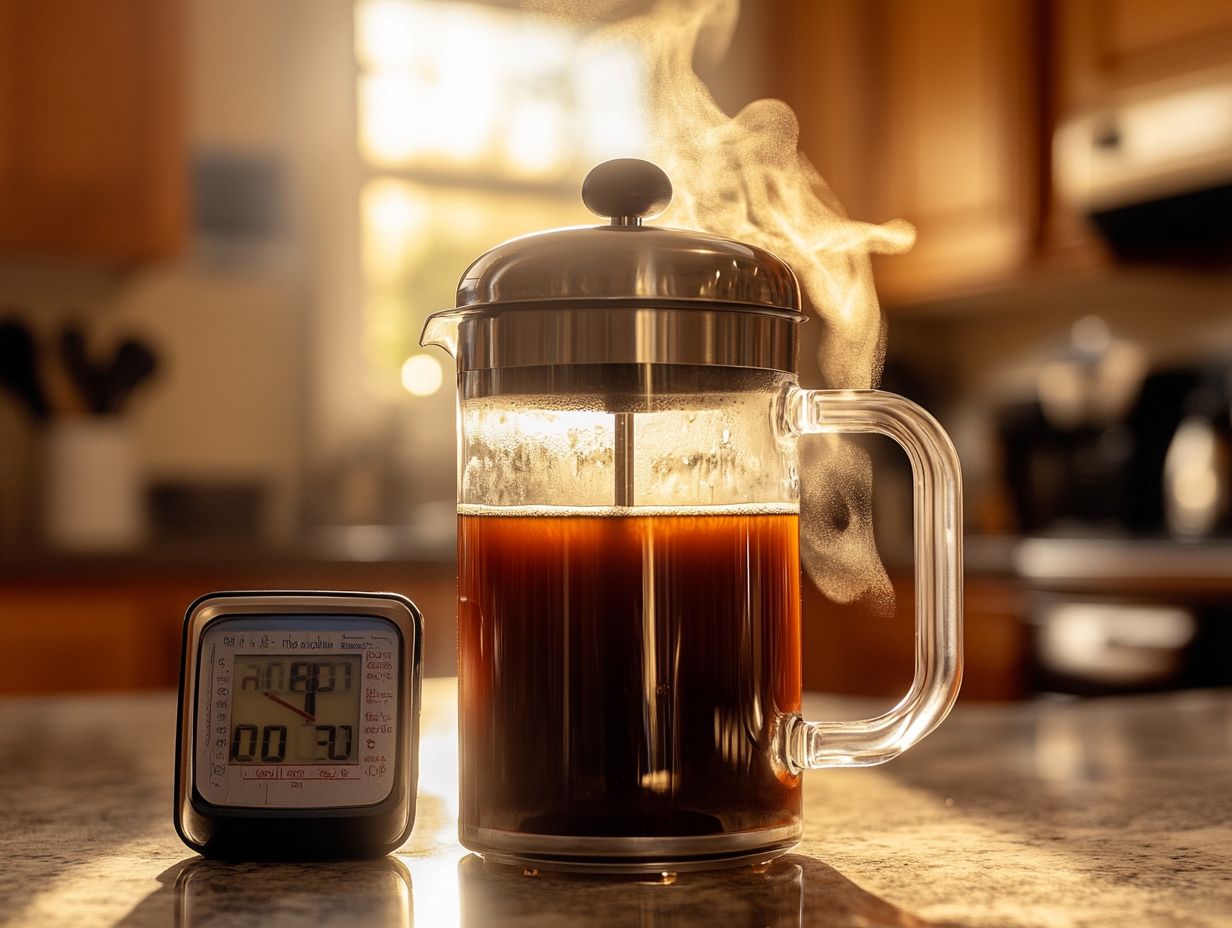
What Is Brew Time?
Brew time is a crucial element in the coffee brewing process that greatly impacts the flavor, strength, and overall quality of your cup. Whether you’re new to coffee brewing or a seasoned coffee enthusiast, understanding this can improve your coffee rituals.
Brew time encompasses the duration during which water interacts with the coffee grounds, extracting those delightful soluble flavors and aromas that shape the final taste profile of your coffee.
Different brewing methods be it the elegant pour-over, the robust French press, the clean Chemex, or the intense espresso demand varying brew times to achieve that perfect extraction.
By understanding how brew time interacts with factors like grind size and the coffee-to-water ratio, you can elevate your coffee experience.
Why Is Brew Time Important in Coffee Flavor?
Brew time is crucial in shaping the flavor profile of your coffee, directly influencing the extraction of essential oils, acids, and aromatic compounds from the grounds. Controlling brew time allows for the perfect balance of these elements.
If your brew time is too short, you risk under-extraction, which can lead to a sour taste and a disappointing lack of complexity.
On the flip side, letting it brew for too long can result in over-extraction, yielding a bitter flavor that obscures the coffee’s natural qualities. Mastering the art of brew time is essential for crafting a well-balanced and flavorful cup that will delight any coffee enthusiast.
What Happens During Brew Time?
During brew time, water engages in a fascinating chemical interaction with coffee grounds known as the process of extracting flavors and aromas from coffee grounds. This is where the magic happens: solubles dissolve into the water, imparting the rich flavors, enticing aromas, and luscious oils that define your coffee experience.
The grind size of your coffee beans is crucial in this process; finer grinds increase surface area, leading to quicker extraction, while coarser grinds may need a bit more time to achieve similar results. This stage is essential for crafting the overall flavor profile, impact, and aromatic qualities of your cup.
The extraction process is influenced by several key factors, including water temperature, brew time, and the coffee-to-water ratio. Higher temperatures tend to ramp up the extraction rate, bringing out vibrant notes in your brew, while cooler temperatures yield a more delicate flavor.
As the water soaks through the coffee grounds, it dissolves different solubles at varying rates, creating a harmonious balance of sweetness, acidity, and bitterness in your final cup. Proper grind size and accurate coffee-to-water ratios ensure optimal brewing.
By understanding these dynamics, you gain the ability to control the brew with finesse, allowing you to fine-tune the flavor experience and ensure that each cup is not only satisfying but also uniquely yours.
How Does Brew Time Affect Coffee Flavor?
Brew time plays a pivotal role in shaping the flavor of your coffee, influencing the extraction of various compounds. This leads to an impressive array of taste profiles based on how long you brew. Understanding the importance of brewing time can help avoid under-extraction or over-extraction.
If your brew time is too short, you might end up with a sour cup, as the acidity comes through without the balancing sweetness. On the flip side, brewing for too long can result in over-extraction, delivering a bitter brew that can overwhelm your palate.
Mastering brew time is essential for any coffee enthusiast seeking to craft balanced and flavorful beverages. Take the French press, for example; a steeping time of about four minutes typically strikes the perfect balance, allowing rich, full-bodied flavors to emerge without tipping into bitterness.
In contrast, with a pour-over method, you ll want to keep it shorter around two to three minutes to steer clear of an overly acidic cup. And let s not forget cold brew, which calls for an extended extraction time of 12 to 24 hours. This process yields a smooth, less acidic coffee that showcases delightful chocolaty notes.
By experimenting with these brewing times, you can fine-tune your techniques. Achieve the flavor profile that perfectly suits your taste. This is essential for crafting balanced beverages, whether in manual brewing or automated brewing settings.
What Are the Optimal Brew Times for Different Coffee Types?
Different coffee types require varying optimal brew times to achieve the best flavor extraction. Each brewing method has its own ideal duration. For instance, pour-over coffee typically benefits from a brew time of 2 to 4 minutes, while a French press demands about 4 to 5 minutes for that perfect extraction.
In contrast, espresso brewing is a speedy affair, often needing just 25 to 30 seconds. Cold brew stands out in the coffee world, steeping for a leisurely 12 to 24 hours, highlighting the rich diversity of brewing techniques and their influence on your final cup.
Understanding these timeframes can significantly enhance your coffee experience, as they impact how sweetness, acidity, and bitterness emerge in the brewed cup. Coffee lovers must appreciate these nuances to master their coffee brewing methods.
For instance, under-extracting can lead to a sour or weak flavor, while over-extracting might introduce an unwelcome bitterness. Thus, it s wise for you, as a coffee enthusiast, to experiment with your brewing times and methods.
Whether you re using a clever dripper, an Aeropress, or the traditional stovetop, exploring the nuances of brew duration can reveal a spectrum of flavors. This makes each coffee experience distinctly delightful.
Invite your friends and fellow coffee aficionados to join you in this exploration. Transform each brew session into a delightful adventure in taste. Consider coffee subscriptions or coffee kits as gifts to enhance your coffee exploration journey.
Factors That Affect Brew Time
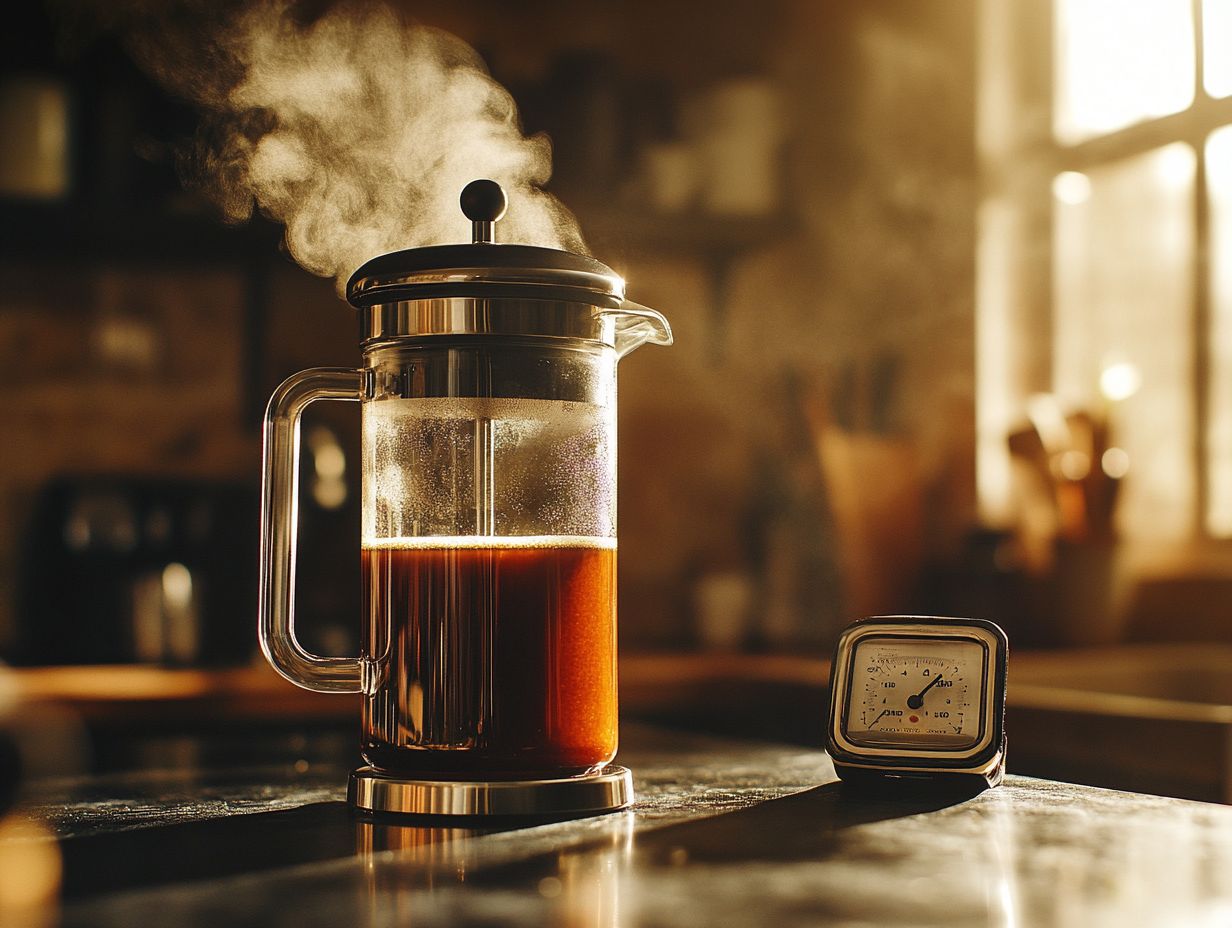
Several factors intricately shape brew time in coffee brewing. It is crucial for you, as a coffee enthusiast or professional, to grasp their influence on the final cup. Whether using a clever dripper, AeroPress, or traditional methods, each factor matters.
Consider grind size; it dictates surface area and extraction rate, playing a pivotal role in flavor development. The coffee bed and how the grounds settle also influence the extraction process.
Water temperature is another critical element, as it directly impacts the solubility of various compounds within the coffee. Roast level also affects flavor extraction, while the brewing method you choose comes with its own specific timing nuances.
Even altitude matters, altering boiling points and extraction rates. By understanding these components, you gain better control over the brewing variables, ultimately enhancing your coffee experience to new heights.
1. Grind Size
Grind size plays a pivotal role in determining brew time. It significantly impacts how flavors are extracted from coffee grounds during the brewing process.
When you opt for a finer grind, you’re increasing the surface area, which accelerates extraction. On the other hand, coarser grinds necessitate longer brew times to achieve similar flavor profiles.
Consider how different brewing methods underscore the need to adjust grind size. For instance, espresso requires fine grounds, while French press favors coarser grinds to elevate both flavor and strength in your coffee.
Take the pour-over method as an example: when you use a medium grind, water flows through the coffee grounds more evenly. This is in contrast to a French press, where a coarse grind facilitates a slower extraction.
This distinction highlights the importance of timing. If the grind is too fine and brewed for too long, you might end up with a bitter cup. Conversely, a coarse grind that isn t brewed long enough could result in a weak brew.
By understanding how grind size affects extraction rates, you ll quickly elevate your coffee game. Tailor each brew to ensure every cup captures the richness and aroma that aligns with your preferred brewing style. For a more detailed brewing guide, consider exploring resources within the specialty coffee movement.
2. Water Temperature in Coffee Brewing
Water temperature plays a pivotal role in determining brew time. It influences how effectively flavors and compounds are drawn from your coffee grounds.
Typically, higher temperatures expedite extraction, while lower temperatures slow the process. This can significantly impact the flavor balance of your final cup.
For example, when using a pour-over method, temperatures between 195 F and 205 F yield the best results. In contrast, cold brew relies on much cooler temperatures to extract flavors over an extended period.
This variation in temperature affects the speed at which your coffee is brewed. It also influences the aroma and complexity of the beverage.
In methods like the French press, aiming for a temperature range of 190 F to 200 F is ideal for achieving that rich, full-bodied flavor you crave. Tasting coffee at different temperatures can further enhance your appreciation of its nuanced flavors.
Be cautious, though; using water that s too hot can lead to over-extraction, resulting in undesirable bitter notes. Conversely, brewing with cooler water, around 120 F to 140 F, can produce lighter, more delicate flavors that allow subtle characteristics to shine through.
Ultimately, the temperature choices you make during brewing can profoundly shape your overall coffee experience. These choices help you craft a cup that aligns perfectly with your personal preferences.
3. Roast Level
The roast level of coffee beans plays a crucial role in influencing both brew time and the flavor profile of your finished cup. Darker roasts extract more quickly during brewing due to their oilier surface and lower density.
On the other hand, lighter roasts require a bit more time to achieve optimal extraction. By understanding the nuances of roast levels, you can tailor your brewing methods and times to bring out the flavors and aromas you desire.
A medium roast typically offers a well-balanced flavor. It thrives with a brewing time of about four to five minutes, making it a perfect match for methods like pour-over or French press.
In contrast, lighter roasts, known for their bright acidity and complex flavors, benefit from a slightly longer steep around five to six minutes to ensure that all those delicate notes fully develop.
By adapting your brewing technique to align with the roast characteristics, you not only enhance the overall taste but also elevate your sensory experience. This allows you to fully appreciate the artistry in each cup.
Try out different techniques or share your experiences with coffee brewing to foster engagement!
How to Control Brew Time for Consistent Coffee Flavor
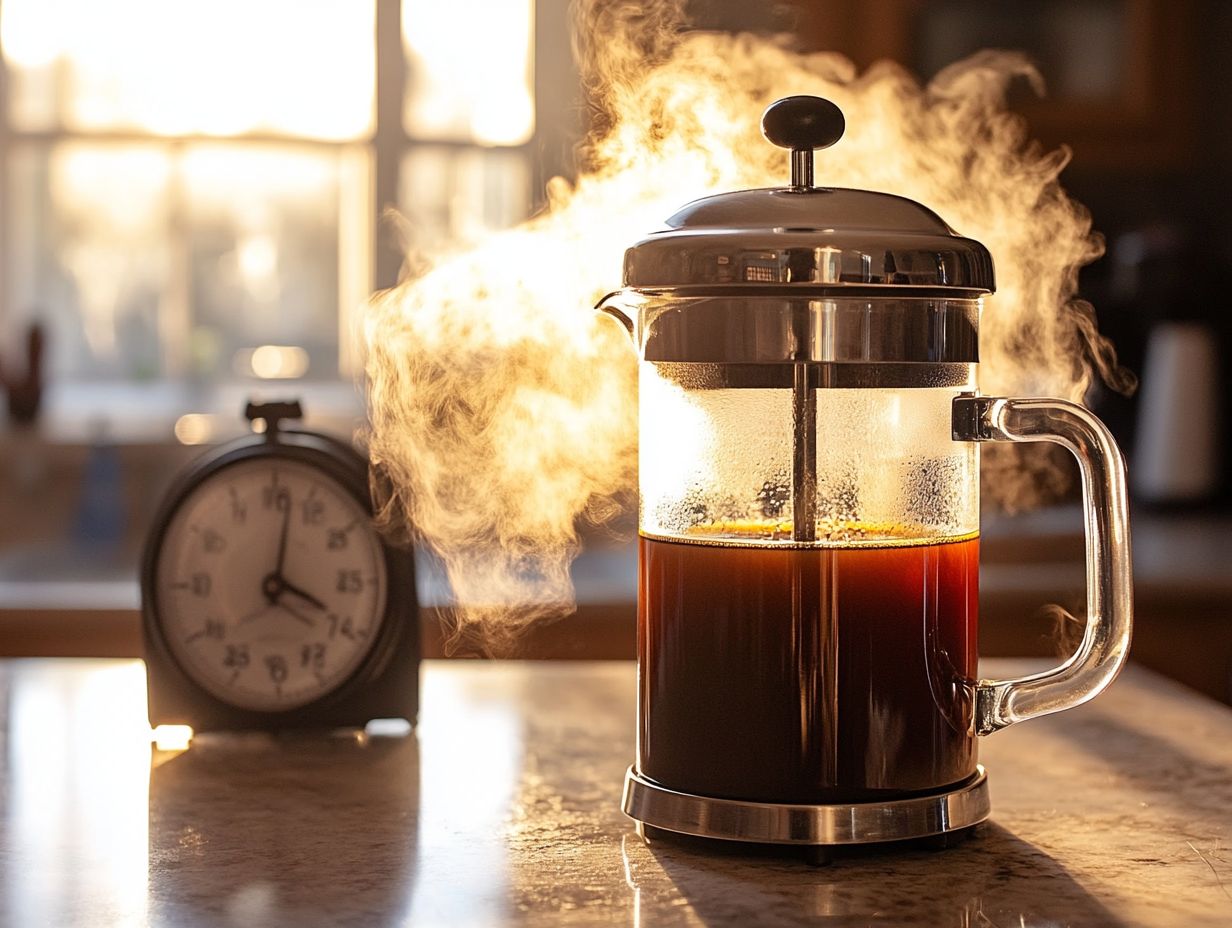
Controlling brew time is key to achieving a consistently exquisite coffee flavor. This enables you as a home barista or coffee enthusiast to refine your brewing techniques for best results.
By embracing specific practices like using a timer, trying different grind sizes, and adjusting water temperature you can master the art of brew time control. This precision elevates your coffee experience and allows you to replicate successful brews with confidence.
1. Use a Timer
Using a timer is one of the simplest yet most effective methods for controlling your brew time. This ensures you achieve a consistent coffee flavor with every cup.
By measuring the brewing duration accurately, you can avoid over-extraction or under-extraction. This leads to a more balanced and flavorful cup of coffee.
Incorporating a timer into your routine promotes consistency and enhances your overall coffee-making precision. For methods like pour-over or French press, the timer ensures that you steep the coffee for just the right amount of time.
For espresso enthusiasts, monitoring extraction time influences the crema the rich foam on top of espresso. A practical tip is to start your timer when you begin brewing, whether pouring water or tamping espresso grounds.
Regardless of your method, remember that experimenting with different times helps you discover the perfect brew for your taste!
Mastering Coffee Brewing Techniques
2. Experiment with Different Grind Sizes
Experimenting with different grind sizes is a crucial strategy for you to control brew time and enhance the flavor of your coffee. The grind size directly influences extraction rates during the brewing process. By adjusting the coarseness or fineness of your coffee grounds, you can tailor the brew time to achieve your desired flavor profile, allowing for a truly personalized coffee experience.
This experimentation invites you to discover the perfect balance of taste and strength that aligns with your palate.
For instance, a finer grind is typically ideal for espresso, creating a rich, intense flavor in a shorter extraction time. In contrast, a coarse grind works wonderfully for methods like the French press. This method allows for a longer steeping process that emphasizes boldness.
To find the ideal grind size for each method, start with a recommended size and make adjustments based on your taste preferences. Keep a notebook handy to jot down your observations. This way, you can refine your approach over time and unlock the full potential of every brew.
Remember, coffee brewing combines both science and art. Embrace the opportunity to experiment until you discover your perfect cup.
3. Adjust Water Temperature
Adjusting water temperature is important for controlling how long you brew coffee and influencing coffee extraction. Varying temperatures can either speed up or slow down the brewing process. To achieve optimal extraction, it s essential for you to discover the ideal water temperature that harmonizes with your chosen brewing method and roast level.
This practice not only elevates the flavor balance of your coffee but also enables you to refine your brewing techniques for consistently exceptional results.
Understanding the science behind coffee brewing, you should be aware that temperatures between 195 F and 205 F are generally regarded as ideal for most brewing methods, including drip and pour-over. If you choose to explore cold brewing, a much lower temperature range of 60 F to 70 F is recommended. This allows for a smoother, less acidic cup.
For espresso aficionados, a slightly higher temperature can enhance richness and complexity while effectively managing extraction time.
By experimenting with these parameters, you can customize your brew to suit your personal tastes, fostering a deeper connection to the beverage you cherish each day.
4. Try Different Brewing Methods
Dive into the fascinating world of brewing methods today! Exploring different brewing methods invites you on an exhilarating journey into the intricate world of coffee. Here, brew time control reveals a symphony of flavor profiles.
Each technique be it pour-over, French press, espresso, or AeroPress carries its own unique characteristics. Each method demands specific brew times to achieve optimal extraction.
Take the pour-over method, for instance; it emphasizes precision and timing, which is crucial as timing in brewing allows those delicate flavor notes to truly shine. In contrast, the French press creates a fuller-bodied experience, thanks to its longer steeping time.
Espresso, on the flip side, requires high pressure and quick extraction, delivering a concentrated shot brimming with robust flavors. The AeroPress stands out for its versatility, enabling you to tweak brew time and water temperature. This results in a distinct cup that can shift dramatically with just minor adjustments.
Each brewing method presents a unique opportunity for you to fine-tune your process and deepen your appreciation for the complexities that coffee has to offer.
5. Take Note of Altitude
Paying attention to altitude is often an overlooked yet crucial factor in mastering brew time control. It can significantly influence coffee extraction and flavor. As altitude increases, the boiling point of water decreases. This prompts you to adjust your brewing methods and times to account for those slower rates of flavor extraction from the coffee grounds. Acknowledging this variable enables you to refine your brewing practices, helping you achieve amazing, consistent results every time you brew.
For instance, if you reside in the mountains, you might discover that your favorite brewing technique produces slightly different flavors than you anticipated due to the altered boiling temperature. If not managed properly, this can lead to under-extraction, resulting in a lackluster cup of coffee. Therefore, adjusting your brewing time for better extraction becomes essential, along with considering factors like grind size and water temperature.
By taking your specific altitude into account, you can unearth unique flavors that reflect your local conditions. This elevates your brewing experience and crafts a more enjoyable drink that is perfectly tailored to your environment.
6. Keep Track of Roast Levels
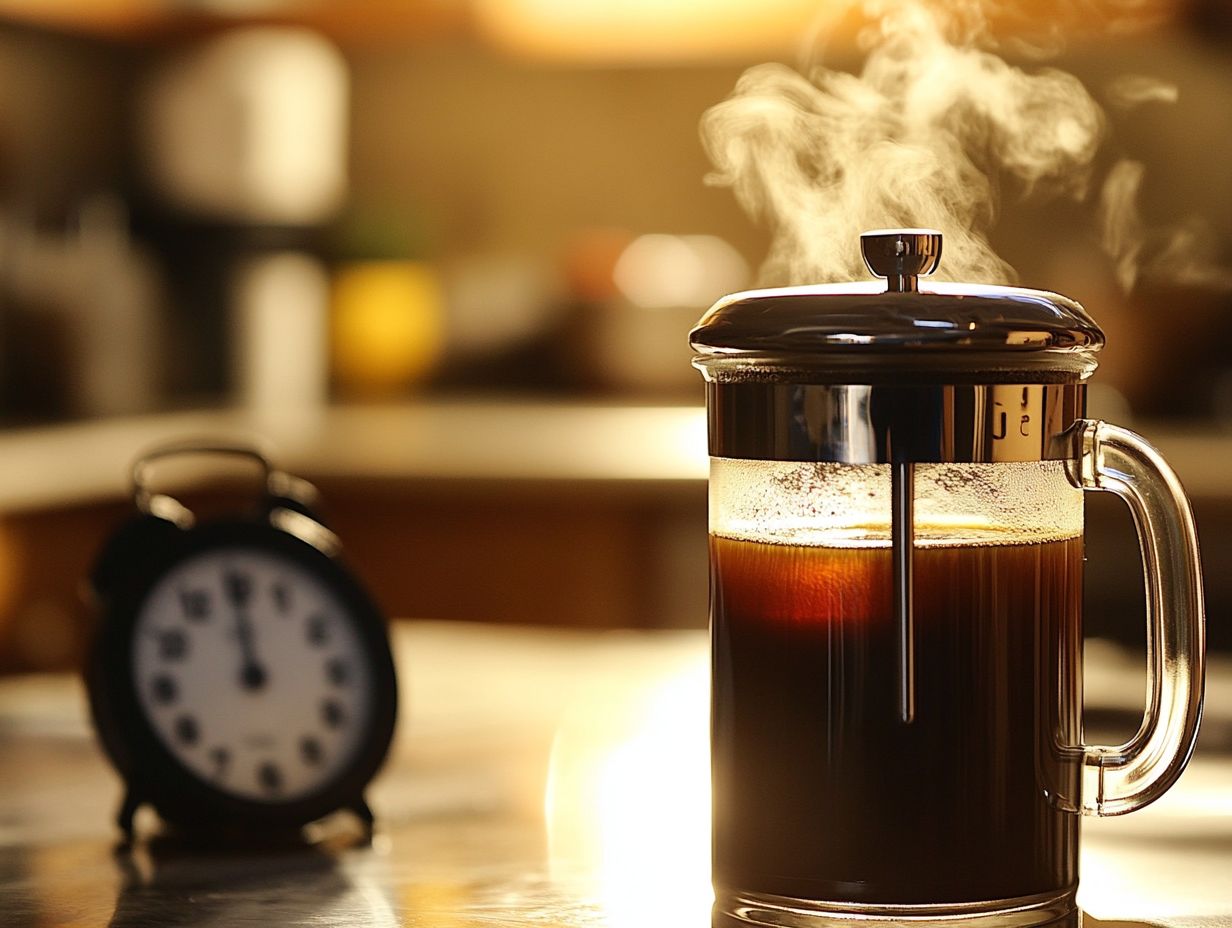
Keeping track of roast levels is crucial for controlling brew time and achieving the best way to get flavor from the coffee. Different roasts demand tailored brewing methods. Lighter roasts, which tend to be denser, may require longer brew times to fully unlock their flavors, while darker roasts, being less dense, typically extract more quickly.
Understanding the subtleties of roast levels helps you adapt your brewing techniques to elevate the overall flavor experience. This adaptability ensures that every cup you brew showcases the intended taste profile, highlighting the vibrant fruity notes in lighter blends or the rich chocolate tones found in darker roasts.
To achieve the best results, experiment with water temperature and grind size. These elements also significantly influence extraction. For instance, using a coarser grind with a lighter roast can promote a slower extraction, allowing delicate flavors to flourish.
On the flip side, a finer grind with a darker roast can enhance boldness, but it requires careful attention to avoid veering into bitterness. By mastering the art of adjusting roast levels, you will unlock a richer, more satisfying cup of coffee that truly resonates with your palate.
Frequently Asked Questions
What is the importance of brew time in coffee flavor?
Brew time is crucial in determining the flavor of your coffee. It directly affects the extraction rate of the coffee grounds, which impacts the strength and taste of your coffee.
How long should I brew my coffee for optimal flavor?
The ideal brew time can vary depending on the brewing method and personal preference. However, a general guideline is to brew for 4-6 minutes for drip coffee and 2-4 minutes for a French press.
What happens if I brew my coffee for too long?
Leaving your coffee brewing for too long can result in over-extracted and bitter coffee. This means that the water has spent too much time extracting the compounds from the coffee grounds, resulting in an unpleasant taste.
What are the effects of a shorter brew time?
A shorter brew time can lead to under-extracted coffee. This occurs when the water has not had enough time to fully extract the flavors from the coffee grounds, resulting in a weak and sour tasting coffee.
Can the brew time be adjusted for different types of coffee beans?
Yes, different types of coffee beans can have different optimal brew times. For example, lighter roasted beans may require a longer brew time to fully extract their flavors, while darker roasted beans may only need a shorter brew time.
How can I control the brew time for my coffee?
You can control the brew time by adjusting the grind size of your coffee beans and the amount of water used. Finer grinds will result in a slower extraction rate, while coarser grinds will extract faster. Using a scale to measure the amount of water can also help to ensure consistency in your brew time.

